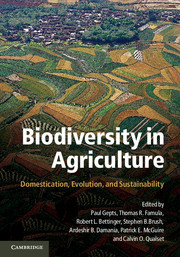Book contents
- Frontmatter
- Contents
- Tables
- Figures
- Foreword
- Contributors
- Acknowledgments
- Introduction: The Domestication of Plants and Animals: Ten Unanswered Questions
- 1 The Local Origins of Domestication
- Section I Early Steps in Agricultural Domestication
- Section II Domestication of Animals and Impacts on Humans
- Section III Issues in Plant Domestication
- Section IV Traditional Management of Biodiversity
- Section V Uses of Biodiversity and New and Future Domestications
- Index
- References
Introduction: The Domestication of Plants and Animals: Ten Unanswered Questions
Published online by Cambridge University Press: 05 June 2012
- Frontmatter
- Contents
- Tables
- Figures
- Foreword
- Contributors
- Acknowledgments
- Introduction: The Domestication of Plants and Animals: Ten Unanswered Questions
- 1 The Local Origins of Domestication
- Section I Early Steps in Agricultural Domestication
- Section II Domestication of Animals and Impacts on Humans
- Section III Issues in Plant Domestication
- Section IV Traditional Management of Biodiversity
- Section V Uses of Biodiversity and New and Future Domestications
- Index
- References
Summary
Some 15,000 to 10,000 years ago, humans started seeding and harvesting plants and maintaining animals in order to augment the food they obtained from wild-growing plants and hunting. These seemingly simple activities set in motion a long-term process that has led to the dominance of agriculture as we know it today. With the exception of a few remaining hunter–gatherer groups, agriculture has now become the most important source of food for most people. Agriculture is also a major source of feed for animals and of fiber.
This transition from hunting–gathering to agriculture was without a doubt one of the most significant eras in the evolution of humans. It allowed food production on a more intensive and efficient scale than ever before, eventually leading to population increases, labor specialization (and especially a nonagricultural sector), the formation of villages, cities, and states, and the rise of more hierarchical societies and states (MacNeish 1991, Barker 2006).
- Type
- Chapter
- Information
- Biodiversity in AgricultureDomestication, Evolution, and Sustainability, pp. 1 - 8Publisher: Cambridge University PressPrint publication year: 2012
References
- 5
- Cited by

